Analysis of Rare Earth Ores Using Laser-Induced Breakdown Spectroscopy and Laser Ablation Time-of-Flight Mass Spectrometry
Abstract
1. Introduction
2. Materials and Methodology
2.1. Geological Ore Samples
2.2. LIBS System
2.3. LA-TOF-MS Experimental Setup
2.4. EDX Analysis
3. Results and Discussion
3.1. LIBS Emission Studies
3.2. Plasma Characterization
3.3. Compositional Analysis Using LIBS, LA-TOF-MS, and EDX
3.4. Limit of Detection of the Analyzed Rare Earths
4. Conclusions
Author Contributions
Funding
Data Availability Statement
Acknowledgments
Conflicts of Interest
References
- Noack, C.W.; Jain, J.C.; Stegmeier, J.; Hakala, J.A.; Karamalidis, A.K. Rare Earth Element Geochemistry of Outcrop and Core Samples from the Marcellus Shale. Geochem. Trans. 2015, 16, 6. [Google Scholar] [CrossRef] [PubMed]
- Gaft, M.; Nagli, L.; Gornushkin, I.; Raichlin, Y. Review on Recent Advances in Analytical Applications of Molecular Emission and Modelling. Spectrochim. Acta Part B At. Spectrosc. 2020, 173, 105989. [Google Scholar] [CrossRef]
- Gaft, M.; Raichlin, Y.; Pelascini, F.; Panzer, G.; Ros, V.M. Imaging Rare-Earth Elements in Minerals by Laser-Induced Plasma Spectroscopy: Molecular Emission and Plasma-Induced Luminescence. Spectrochim. Acta Part B At. Spectrosc. 2019, 151, 12–19. [Google Scholar] [CrossRef]
- Bhatt, C.R.; Jain, J.C.; Goueguel, C.L.; McIntyre, D.L.; Singh, J.P. Determination of Rare Earth Elements in Geological Samples Using Laser-Induced Breakdown Spectroscopy (LIBS). Appl. Spectrosc. 2018, 72, 114–121. [Google Scholar] [CrossRef] [PubMed]
- Reinhardt, N.; Proenza, J.A.; Villanova-de-Benavent, C.; Aiglsperger, T.; Bover-Arnal, T.; Torró, L.; Salas, R.; Dziggel, A. Geochemistry and Mineralogy of Rare Earth Elements (REE) in Bauxitic Ores of the Catalan Coastal Range, NE Spain. Minerals 2018, 8, 562. [Google Scholar] [CrossRef]
- Lefticariu, L.; Klitzing, K.L.; Kolker, A. Rare Earth Elements and Yttrium (REY) in Coal Mine Drainage from the Illinois Basin, USA. Int. J. Coal Geol. 2020, 217, 103327. [Google Scholar] [CrossRef]
- Cotton, S. Lanthanides and Actinides; Red Globe Press: London, UK; Macmillan Education Ltd.: London, UK, 1991. [Google Scholar]
- Moeller, T. The Chemistry of the Lanthanides; Pergamon Texts in Inorganic Chemistry; Elsevier: Amsterdam, The Netherlands, 2013; Volume 26. [Google Scholar]
- Zawisza, B.; Pytlakowska, K.; Feist, B.; Polowniak, M.; Kita, A.; Sitko, R. Determination of Rare Earth Elements by Spectroscopic Techniques: A Review. J. Anal. At. Spectrom 2011, 26, 2373–2390. [Google Scholar] [CrossRef]
- Orihashi, Y.; Hirata, T. Rapid Quantitative Analysis of Y and REE Abundances in XRF Glass Bead for Selected GSJ Reference Rock Standards Using Nd-YAG 266 nm UV Laser Ablation ICP-MS. Geochem. J. 2003, 37, 401–412. [Google Scholar] [CrossRef]
- Fedorowich, J.S.; Richards, J.P.; Jain, J.C.; Kerrich, R.; Fan, J. A Rapid Method for REE and Trace-Element Analysis Using Laser Sampling ICP-MS on Direct Fusion Whole-Rock Glasses. Chem. Geol. 1993, 106, 229–249. [Google Scholar] [CrossRef]
- Zhang, Y.; Zhang, T.; Li, H. Application of Laser-Induced Breakdown Spectroscopy (LIBS) in Environmental Monitoring. Spectrochim. Acta Part B At. Spectrosc. 2021, 181, 106218. [Google Scholar] [CrossRef]
- Sdvizhenskii, P.A.; Lednev, V.N.; Grishin, M.Y.; Pershin, S.M. Deep Ablation and LIBS Depth Elemental Profiling by Combining Nano- and Microsecond Laser Pulses. Spectrochim. Acta Part B At. Spectrosc. 2021, 177, 106054. [Google Scholar] [CrossRef]
- Cremers, D.A.; Radziemski, L.J.; Loree, T.R. Spectrochemical Analysis of Liquids Using the Laser Spark. Appl. Spectrosc. 1984, 38, 721–729. [Google Scholar] [CrossRef]
- St-Onge, L.; Kwong, E.; Sabsabi, M.; Vadas, E.B. Rapid Analysis of Liquid Formulations Containing Sodium Chloride Using Laser-Induced Breakdown Spectroscopy. J. Pharm. Biomed. Anal. 2004, 36, 277–284. [Google Scholar] [CrossRef]
- Miziolek, A.W.; Palleschi, V.; Schechter, I. (Eds.) Laser Induced Breakdown Spectroscopy; Cambridge University Press: Cambridge, UK, 2006. [Google Scholar]
- Ciucci, A.; Corsi, M.; Palleschi, V.; Rastelli, S.; Salvetti, A.; Tognoni, E. New Procedure for Quantitative Elemental Analysis by Laser-Induced Plasma Spectroscopy. Appl. Spectrosc. 1999, 53, 960–964. [Google Scholar] [CrossRef]
- Fortes, F.J.; Moros, J.; Lucena, P.; Cabalín, L.M.; Laserna, J.J. Laser-Induced Breakdown Spectroscopy. Anal. Chem. 2013, 85, 640–669. [Google Scholar] [CrossRef]
- Gaudiuso, R.; Dell’Aglio, M.; De Pascale, O.; Loperfido, S.; Mangone, A.; De Giacomo, A. Laser-Induced Breakdown Spectroscopy of Archaeological Findings with Calibration-Free Inverse Method: Comparison with Classical Laser-Induced Breakdown Spectroscopy and Conventional Techniques. Anal. Chim. Acta 2014, 813, 15–24. [Google Scholar] [CrossRef] [PubMed]
- Abedin, K.M.; Haider, A.F.M.Y.; Rony, M.A.; Khan, Z.H. Identification of Multiple Rare Earths and Associated Elements in Raw Monazite Sands by Laser-Induced Breakdown Spectroscopy. Opt. Laser Technol. 2011, 43, 45–49. [Google Scholar] [CrossRef]
- Phuoc, T.X.; Wang, P.; McIntyre, D. Detection of Rare Earth Elements in Powder River Basin Sub-Bituminous Coal Ash Using Laser-Induced Breakdown Spectroscopy (LIBS). Fuel 2016, 163, 129–132. [Google Scholar] [CrossRef]
- Bhatt, C.R.; Yueh, F.Y.; Singh, J.P. Univariate and Multivariate Analyses of Rare Earth Elements by Laser-Induced Breakdown Spectroscopy. Appl. Opt. 2017, 56, 2280–2287. [Google Scholar] [CrossRef]
- Castro, J.P.; Babos, D.V.; Pereira-Filho, E.R. Calibration Strategies for the Direct Determination of Rare Earth Elements in Hard Disk Magnets Using Laser-Induced Breakdown Spectroscopy. Talanta 2020, 208, 120443. [Google Scholar] [CrossRef]
- Gaft, M.; Nagli, L.; Gorychev, A.; Raichlin, Y. Rare-Earth Elements Detection Using Diatomic Molecular Laser-Induced Plasma Spectroscopy. Spectrochim. Acta Part B 2022, 192, 106426. [Google Scholar] [CrossRef]
- Harikrishnan, S.; Ananthachar, A.; Choudhari, K.S.; George, S.D.; Chidangil, S.; Unnikrishnan, V.K. Laser-Induced Breakdown Spectroscopy (LIBS) for the Detection of Rare Earth Elements (REEs) in Meteorites. Minerals 2023, 13, 182. [Google Scholar] [CrossRef]
- Fayyaz, A.; Asghar, H.; Alshehri, A.M.; Alrebdi, T.A. LIBS Assisted PCA Analysis of Multiple Rare-Earth Elements (La, Ce, Nd, Sm, and Yb) in Phosphorite Deposits. Heliyon 2023, 9, e13957. [Google Scholar] [CrossRef] [PubMed]
- Ahmed, R.; Ahmed, N.; Iqbal, J.; Baig, M.A. An Inexpensive Technique for the Time Resolved Laser Induced Plasma Spectroscopy. Phys. Plasmas 2016, 23, 083101. [Google Scholar] [CrossRef]
- Iqbal, J.; Mahmood, S.; Tufail, I.; Asghar, H.; Ahmed, R.; Baig, M.A. On the Use of Laser-Induced Breakdown Spectroscopy to Characterize the Naturally Existing Crystal in Pakistan and Its Optical Emission Spectrum. Spectrochim. Acta Part B 2015, 111, 80–86. [Google Scholar] [CrossRef]
- Umar, Z.A.; Ahmed, N.; Ahmed, R.; Liaqat, U.; Baig, M.A. Elemental Composition Analysis of Granite Rocks Using LIBS and LA-TOF-MS. Appl. Opt. 2018, 57, 4985–4991. [Google Scholar] [CrossRef]
- Fayyaz, A.; Liaqat, U.; Yaqoob, K.; Ahmed, R.; Umar, Z.A.; Baig, M.A. Combination of Laser-Induced Breakdown Spectroscopy and Time-of-Flight Mass Spectrometry for the Quantification of CoCrFeNiMo High Entropy Alloys. Spectrochim. Acta Part B 2022, 198, 106562. [Google Scholar] [CrossRef]
- Jabbar, A.; Akhtar, M.; Mehmood, S.; Ahmed, N.; Umar, Z.A.; Ahmed, R.; Baig, M.A. On the Detection of Heavy Elements in the Euphorbia indica Plant Using Laser-Induced Breakdown Spectroscopy and Laser Ablation Time-of-Flight Mass Spectrometry. J. Anal. At. Spectrom. 2019, 34, 954–962. [Google Scholar] [CrossRef]
- Ahmed, N.; Ahmed, R.; Umar, Z.A.; Baig, M.A. Laser Ionization Time-of-Flight Mass Spectrometer for Isotope Mass Detection and Elemental Analysis of Materials. Laser Phys. 2017, 27, 086001. [Google Scholar] [CrossRef]
- NIST Database. 2021. Available online: https://physics.nist.gov/PhysRefData/ASD/lines_form.html (accessed on 30 September 2022).
- Cremers, D.A.; Radziemski, L.J. Handbook of Laser-Induced Breakdown Spectroscopy; John Wiley & Sons: Hoboken, NJ, USA, 2013. [Google Scholar]
- Asghar, H.; Ali, R.; Baig, M.A. Determination of Transition Probabilities for the 3p → 3s Transition Array in Neon Using Laser Induced Breakdown Spectroscopy. Phys. Plasmas 2013, 20, 123302. [Google Scholar] [CrossRef]
- Zhang, S.; Wang, X.; He, M.; Jiang, Y.; Zhang, B.; Hang, W.; Huang, B. Laser-Induced Plasma Temperature. Spectrochim. Acta Part B 2014, 97, 13–33. [Google Scholar] [CrossRef]
- Zhang, P.; Liu, X.; Lin, M.; Zhang, J. Research on the Spatio-Temporal Characteristics of High Energy Pulsed Plasma Jets. Phys. Plasmas 2022, 29, 093505. [Google Scholar] [CrossRef]
- Aragón, C.; Aguilera, J.A. Characterization of Laser-Induced Plasmas by Optical Emission Spectroscopy: A Review of Experiments and Methods. Spectrochim. Acta Part B 2008, 63, 893–916. [Google Scholar] [CrossRef]
- Griem, H. Principles of Plasma Spectroscopy; Cambridge Monographs on Plasma Physics; Cambridge University Press: Cambridge, UK, 1997. [Google Scholar]
- Harilal, S.S.; Brumfield, B.E.; LaHaye, N.L.; Hartig, K.C.; Phillips, M.C. Optical Spectroscopy of Laser-Produced Plasmas for Standoff Isotopic Analysis. Appl. Phys. Rev. 2018, 5, 021301. [Google Scholar] [CrossRef]
- McWhirter, R.W.P. Chapter 5. Plasma Diagnostic Techniques; Academic Press: Cambridge, MA, USA, 1965. [Google Scholar]
- Drawin, H.W. Validity Conditions for Local Thermodynamic Equilibrium. Z. Für Phys. 1969, 228, 99–119. [Google Scholar] [CrossRef]
- David, W.; Hahn, R.; Nicolò, F. Laser-Induced Breakdown Spectroscopy (LIBS), Part II: Review of Instrumental and Methodological Approaches to Material Analysis and Applications to Different Fields. Appl. Spectrosc. 2012, 66, 347–419. [Google Scholar]
- Tognoni, E.; Cristoforetti, G.; Legnaioli, S.; Palleschi, V.; Salvetti, A.; Müller, M.; Panne, U.; Gornushkin, I.B. A Numerical Study of Expected Accuracy and Precision in Calibration-Free Laser-Induced Breakdown Spectroscopy in the Assumption of Ideal Analytical Plasma. Spectrochim. Acta Part B 2007, 62, 1287–1302. [Google Scholar] [CrossRef]
- Abbass, Q.; Ahmed, N.; Ahmed, R.; Baig, M.A. A Comparative Study of Calibration Free Methods for the Elemental Analysis by Laser Induced Breakdown Spectroscopy. Plasma Chem. Plasma Process. 2016, 36, 1287–1299. [Google Scholar] [CrossRef]
- Ahmad, N.; Ahmed, R.; Umar, Z.A.; Liaqat, U.; Manzoor, U.; Baig, M.A. Qualitative and Quantitative Analyses of Copper Ores Collected from Baluchistan, Pakistan Using LIBS and LA-TOF-MS. Appl. Phys. B 2018, 124, 160. [Google Scholar] [CrossRef]
- Mermet, J.M. Calibration in Atomic Spectrometry: A Tutorial Review Dealing with Quality Criteria, Weighting Procedures and Possible Curvatures. Spectrochim. Acta Part B 2010, 65, 509–523. [Google Scholar] [CrossRef]
- El Haddad, J.; Canioni, L.; Bousquet, B. Good Practices in LIBS Analysis: Review and Advices. Spectrochim. Acta Part B 2014, 101, 171–182. [Google Scholar] [CrossRef]
- Dai, Y.; Song, C.; Gao, X.; Chen, A.; Hao, Z.; Lin, J. Quantitative Determination of Al–Cu–Mg–Fe–Ni Aluminum Alloy Using Laser-Induced Breakdown Spectroscopy Combined with LASSO–LSSVM Regression. J. Anal. At. Spectrom. 2021, 36, 1634–1642. [Google Scholar] [CrossRef]
- Vardeman, S.B.; Wendelberger, J.R.; Wang, L. Calibration, Error Analysis, and Ongoing Measurement Process Monitoring for Mass Spectrometry. Qual. Eng. 2006, 18, 207–217. [Google Scholar] [CrossRef]
- Uerlings, R.; Matusch, A.; Weiskirchen, R. Standardization and Normalization of Data from Laser Ablation Inductively Coupled Plasma Mass Spectrometry. In Applications of Laser Ablation-Thin Film Deposition, Nanomaterial Synthesis and Surface Modification; Intech Publishing: London, UK, 2016; pp. 399–415. [Google Scholar]
- Kawai, J.; Ishii, H.; Matsui, Y.; Terada, Y.; Tanabe, T.; Uchiyama, I. Risk Assessment of TiO2 Photocatalyst by Individual Micrometer-Size Particle Analysis with On-Site Combination of SEM-EDX and SR-XANES Microscope. Spectrochim. Acta Part B 2007, 62, 677–681. [Google Scholar] [CrossRef]
- Aidene, S.; Semenov, V.; Kirsanov, D.; Kirsanov, D.; Panchuk, V. Assessment of the Physical Properties, and the Hydrogen, Carbon, and Oxygen Content in Plastics Using Energy-Dispersive X-ray Fluorescence Spectrometry. Spectrochim. Acta Part B 2020, 165, 105771. [Google Scholar] [CrossRef]
- Mohamed, W.T.Y. Improved LIBS limit of detection of Be, Mg, Si, Mn, Fe and Cu in aluminum alloy samples using a portable Echelle spectrometer with ICCD camera. Opt. Laser Technol. 2008, 40, 30–38. [Google Scholar] [CrossRef]
- Yang, X.; Hao, Z.; Yi, R.; Li, J.; Yu, H.; Guo, L.; Li, X.; Zeng, X.; Lu, Y. Simultaneous determination of La, Ce, Pr, and Nd elements in aqueous solution using surface-enhanced laser-induced breakdown spectroscopy. Talanta 2017, 163, 127–131. [Google Scholar] [CrossRef]
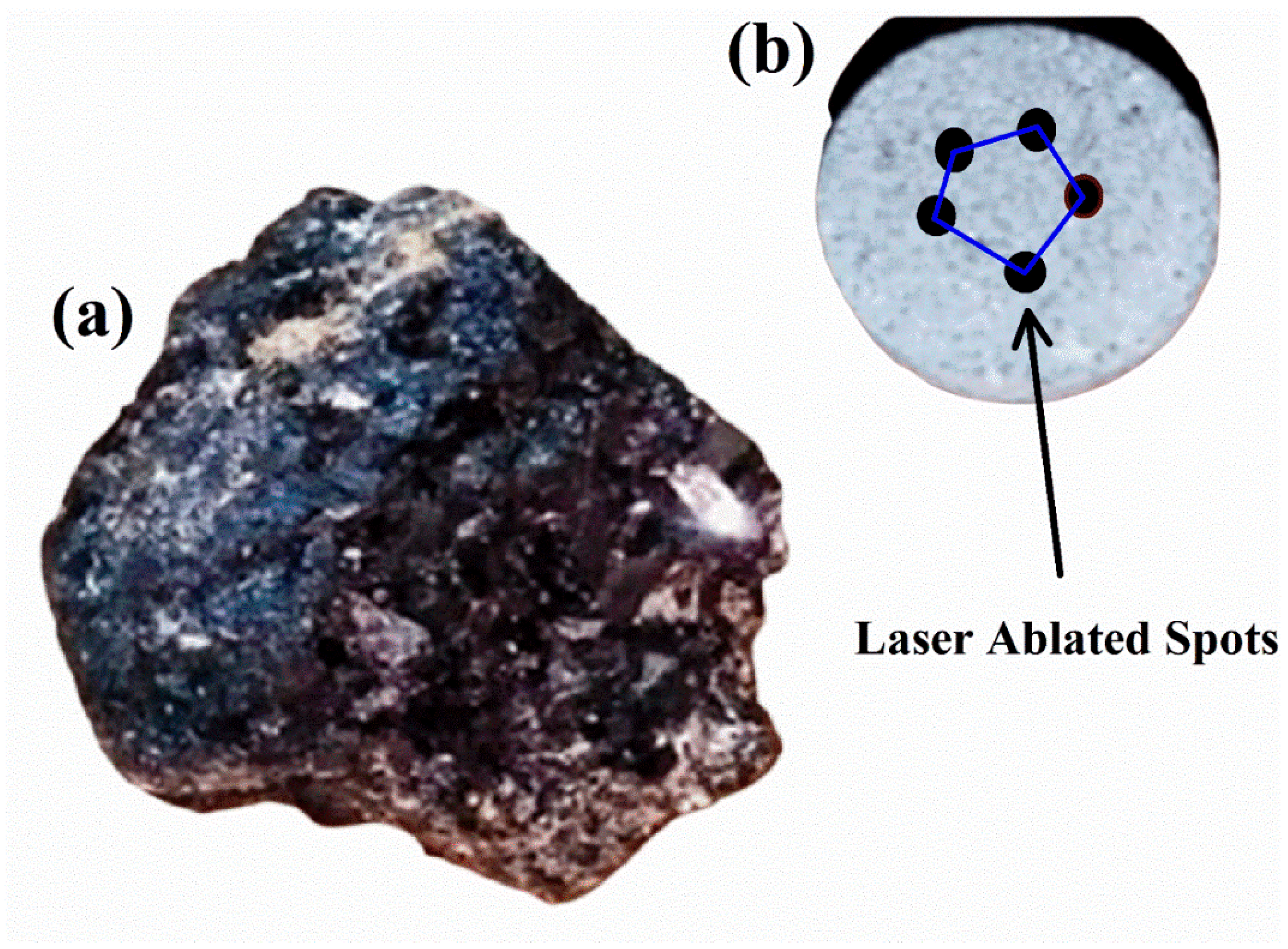
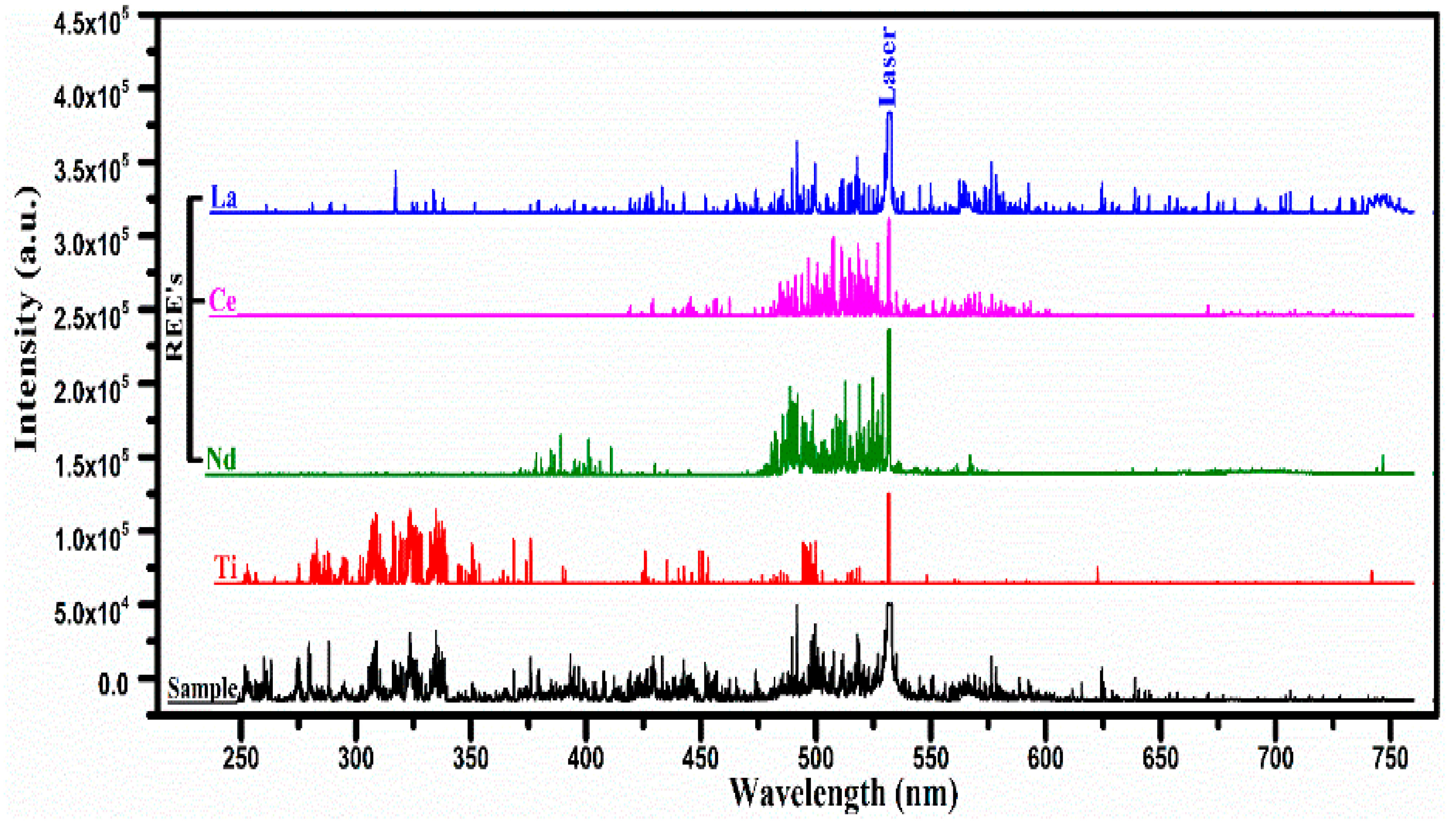
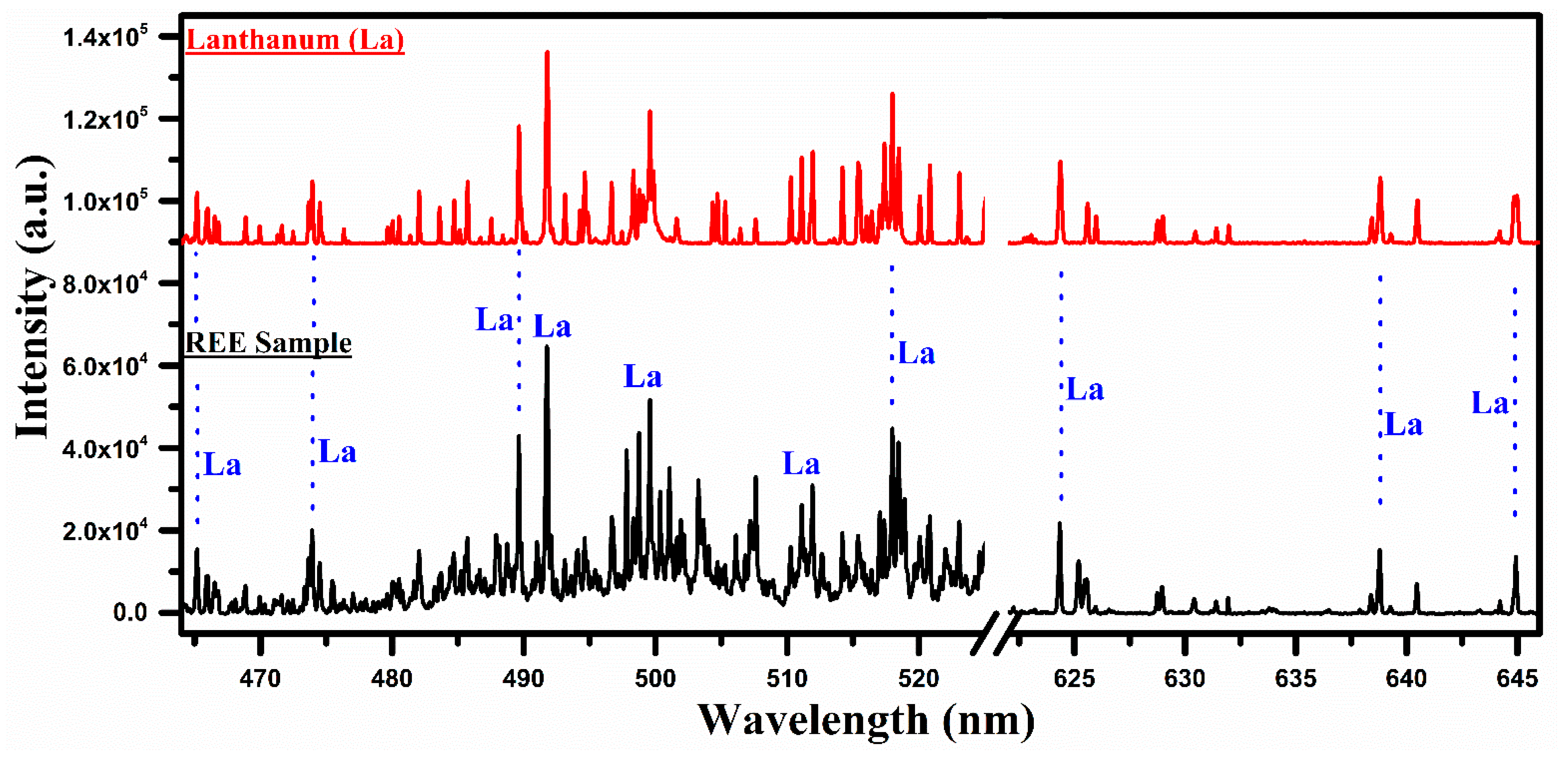
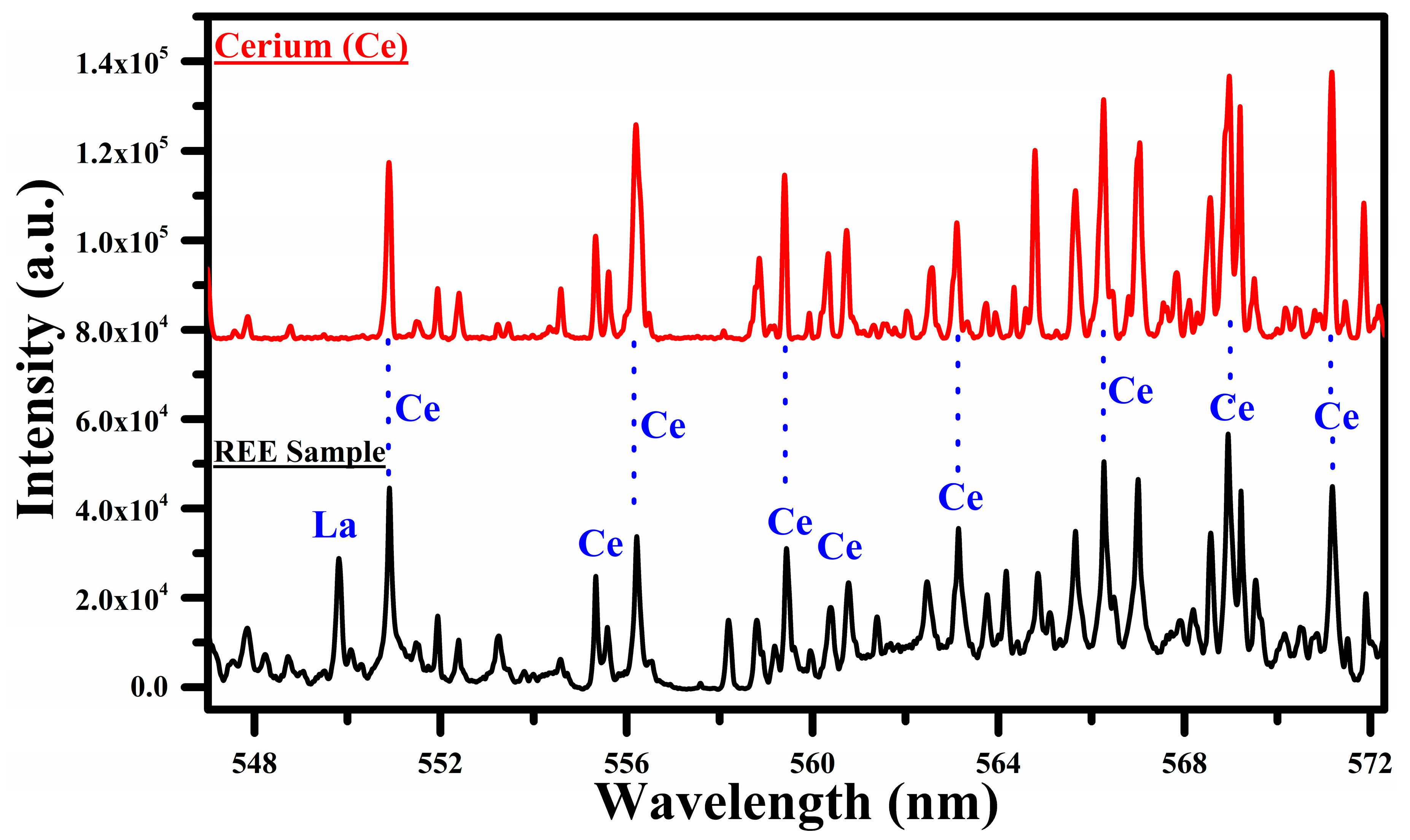
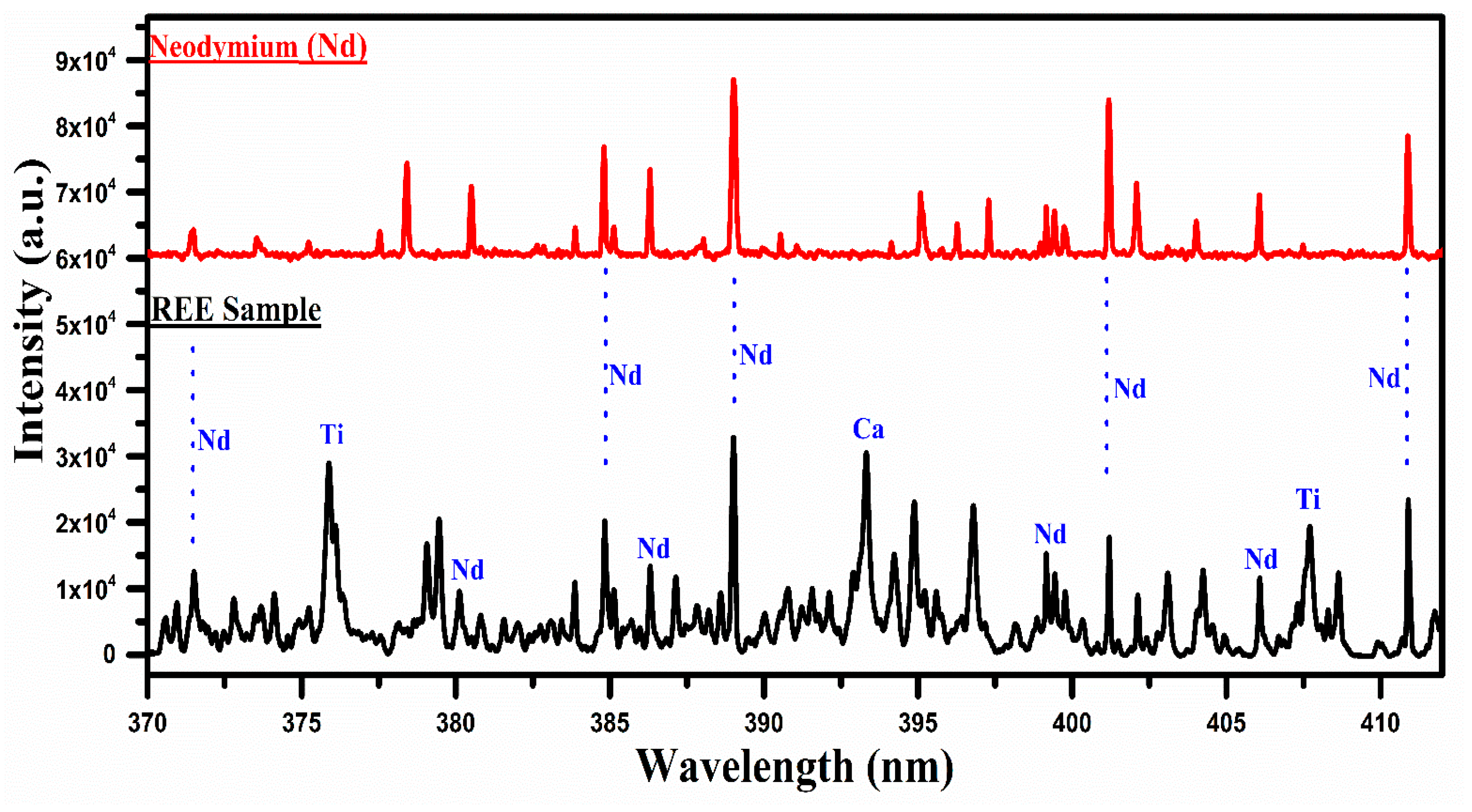
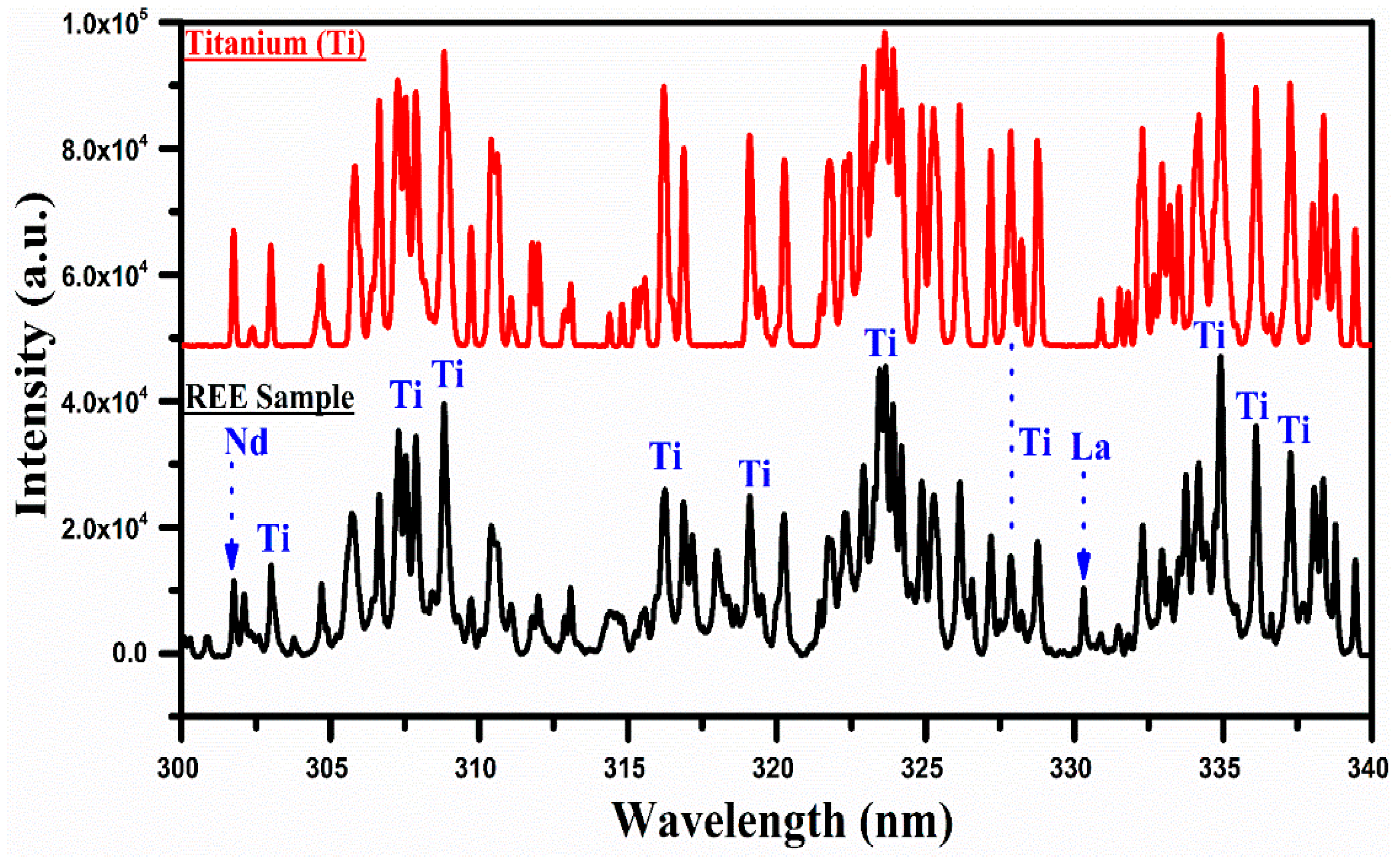
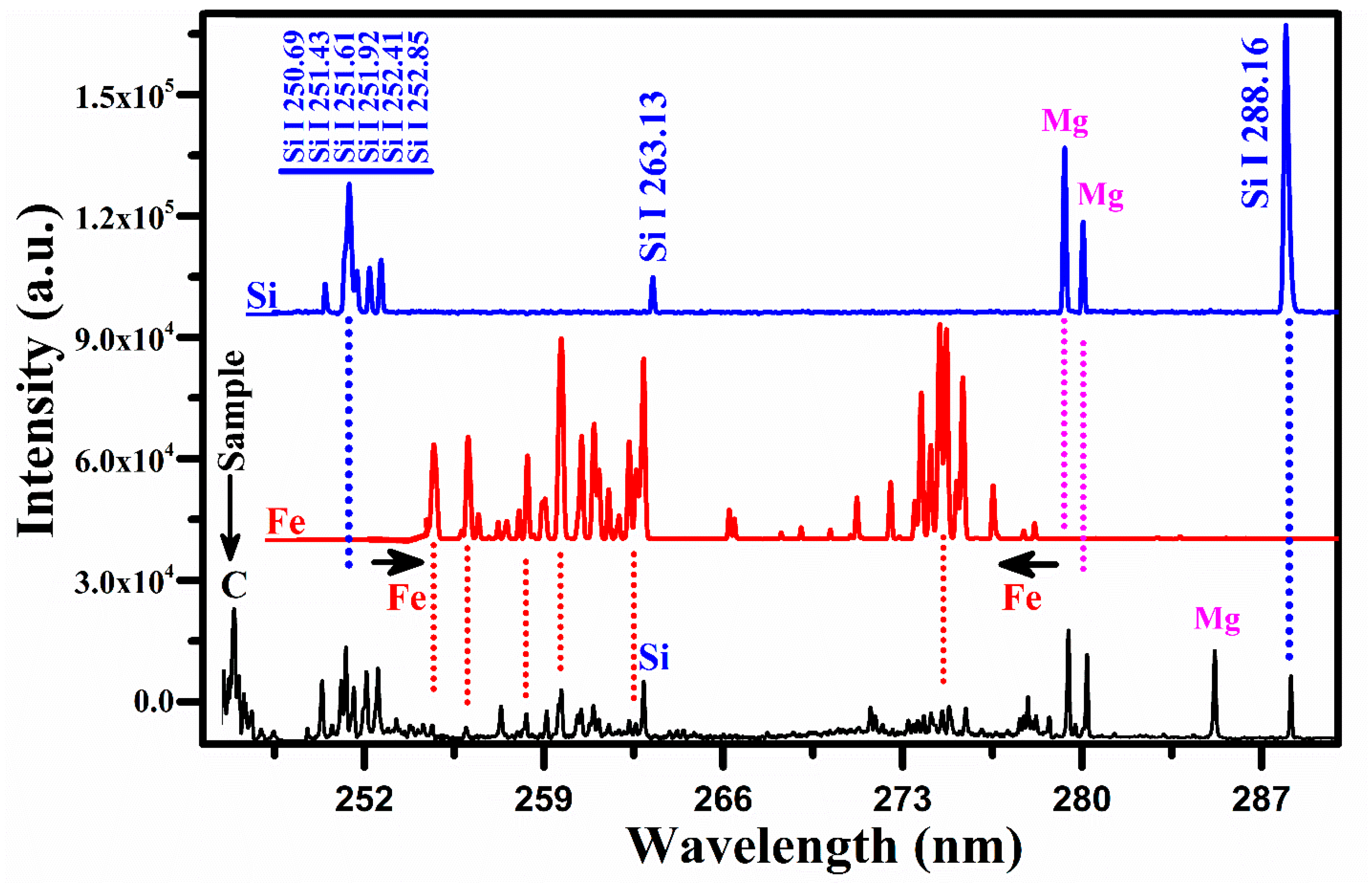
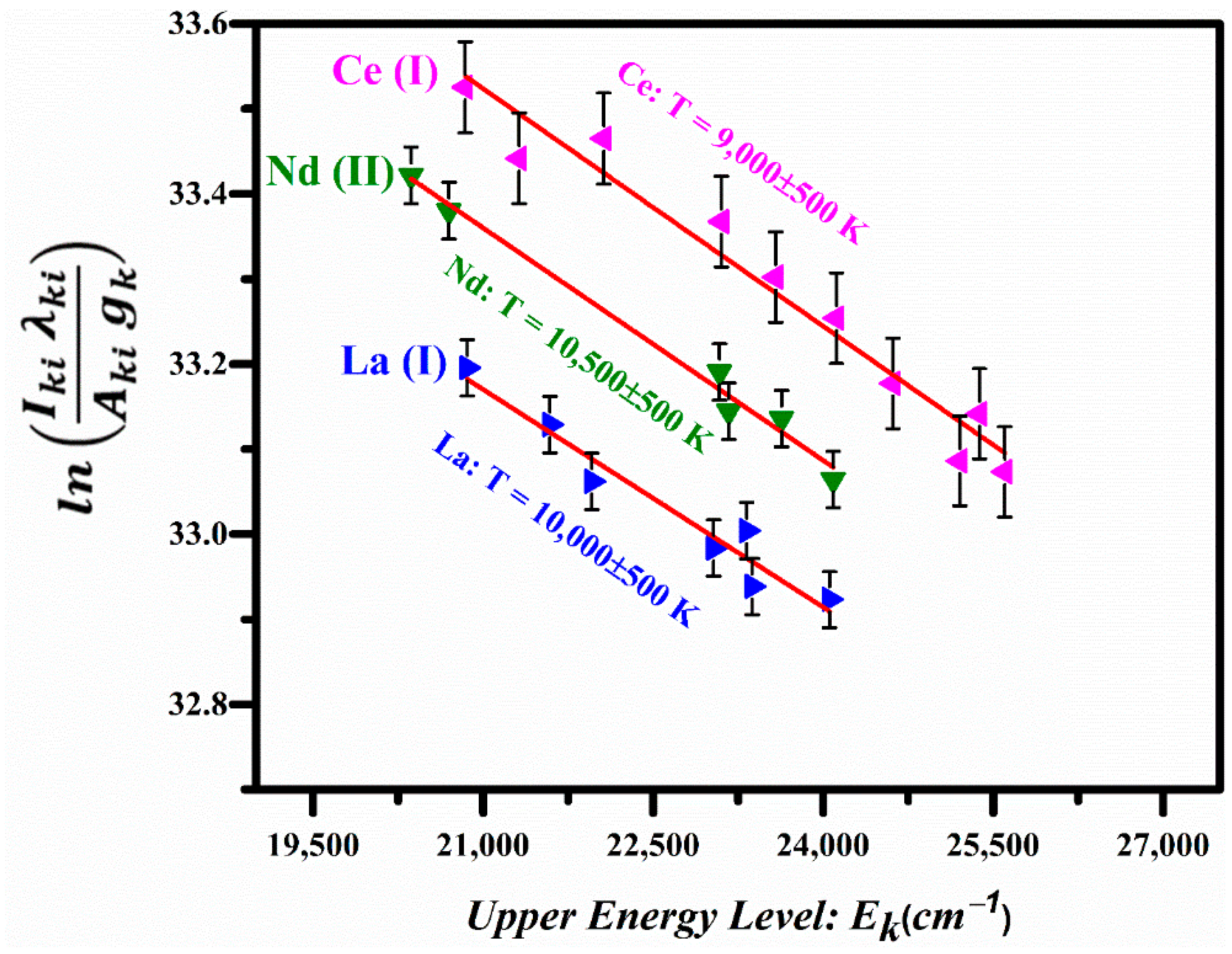
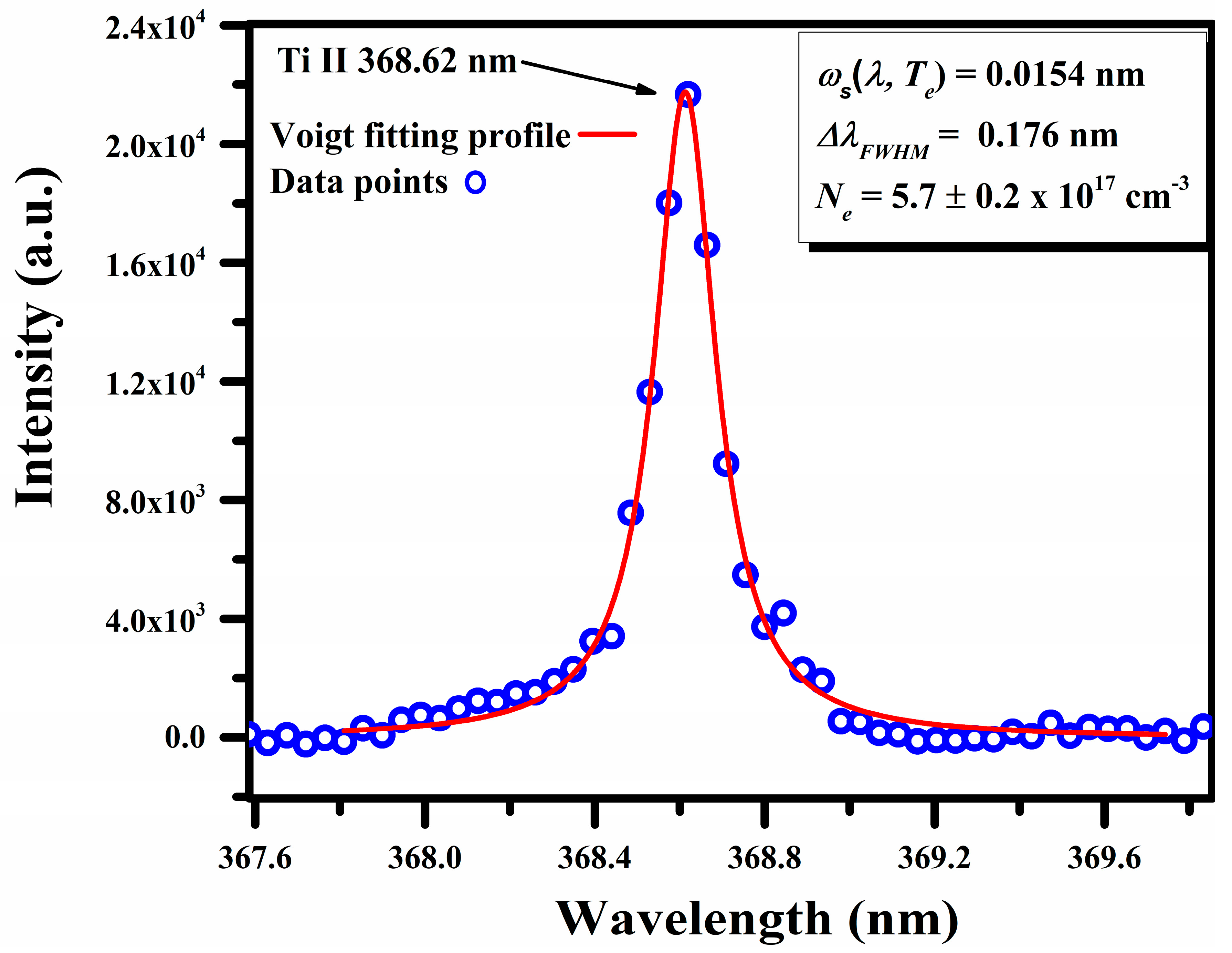
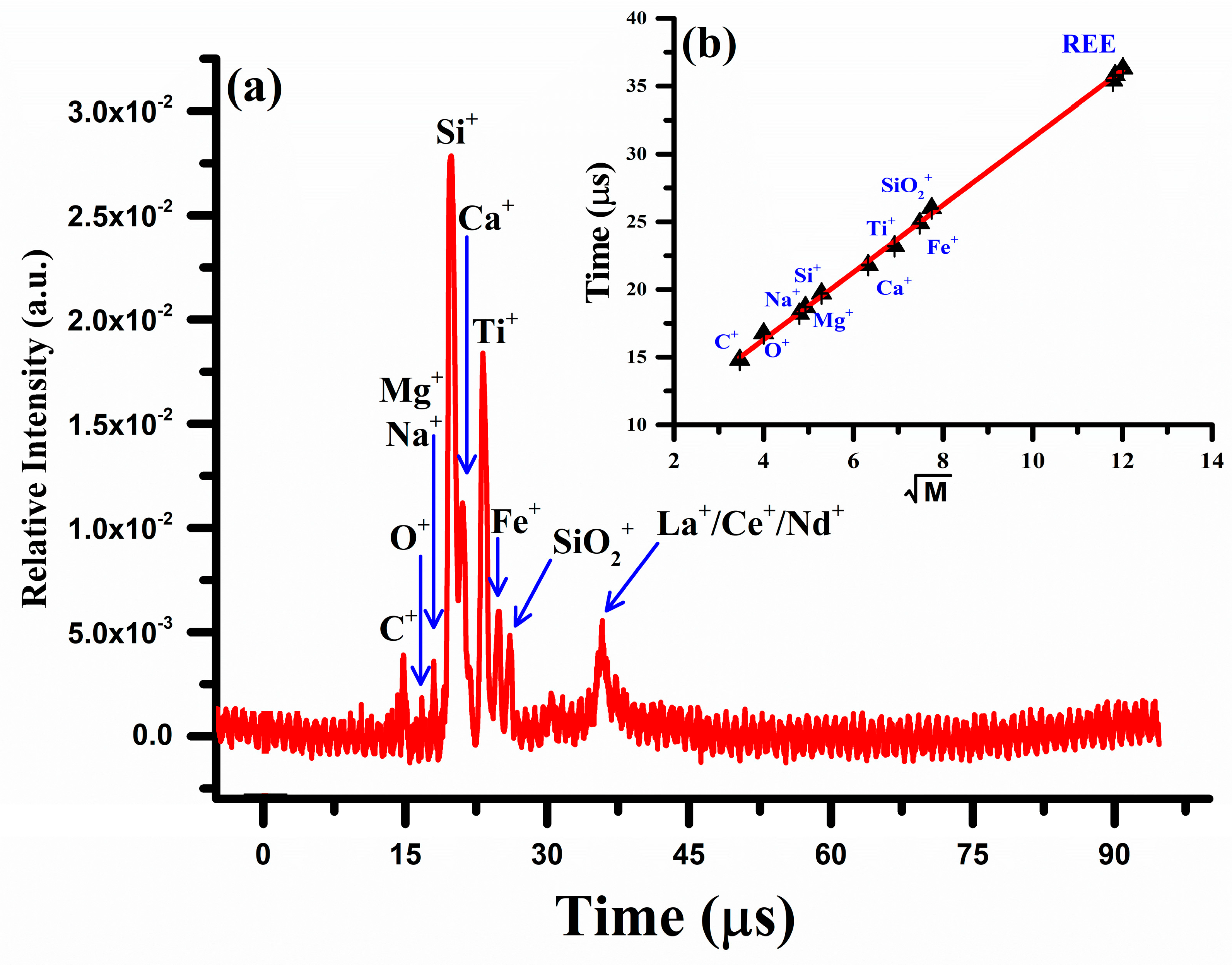


| Species | Observed Wavelength (nm) of Major Emission Spectral Lines of Elements |
|---|---|
| La I La II | 465.03, 470.26, 510.62, 514.54, 515.87, 517.73, 521.19, 523.96, 624.99, 628.86, 629.63 433.38, 452.24, 466.25, 466.89, 472.84, 474.03, 489.99, 492.09, 492.18, 497.04, 498.68, 499.95, 626.23 |
| Ce I Ce II | 544.92, 556.60, 559.59, 560.13, 567.78, 569.29, 569.70, 571.90, 577.31, 578.82, 581.29, 594.09 456.24, 462.82, 526.57, 527.42, 533.05, 535.35, 551.21 |
| Nd I Nd II | 463.42, 488.38, 489.69, 492.45, 494.48, 495.48 371.54, 373.80, 375.27, 377.55, 378.43, 380.23, 380.53, 383.89, 384.83, 386.33, 388.99, 389.15, 395.22, 397.33, 399.01, 399.17, 399.47, 401.23, 402.09, 404.08, 410.91 |
| Ti I Ti II | 319.19, 319.99, 320.38, 321.79, 321.92, 322.14, 322.35, 322.61 301.72, 302.37, 302.97, 304.38, 304.67, 304.88, 305.67, 305.81, 306.35, 306.62, 306.63, 306.65, 307.29, 307.52, 307.86, 308.18, 308.80, 308.93, 334.90, 334.94, 336.12, 337.28, 338.38 |
| Si I | 250.69, 251.43, 251.61, 251.92, 252.41, 252.85, 263.13, 288.16 |
| Fe I | 271.90, 272.09, 296.69, 302.06 |
| Fe II | 258.58, 259.94, 260.71, 261.19, 263.11, 273.95, 275.57 |
| Wavelength (nm) | Transition Probability () | ||
|---|---|---|---|
| Lanthanum (La I) | |||
| 465.03 | 0.054 | 6 | 3.04 |
| 470.26 | 0.049 | 8 | 3.15 |
| 510.62 | 1.050 | 2 | 2.76 |
| 515.87 | 0.110 | 6 | 2.40 |
| 517.73 | 0.820 | 6 | 2.83 |
| 628.86 | 0.080 | 2 | 3.18 |
| 629.36 | 0.046 | 6 | 2.40 |
| Cerium (Ce I) | |||
| 544.92 | 0.34 | 15 | 2.99 |
| 556.60 | 0.28 | 11 | 2.69 |
| 559.59 | 0.21 | 13 | 2.77 |
| 560.13 | 0.65 | 17 | 3.06 |
| 567.78 | 0.21 | 15 | 2.74 |
| 569.70 | 0.51 | 17 | 2.83 |
| 571.90 | 0.51 | 17 | 2.89 |
| 577.31 | 0.26 | 15 | 2.73 |
| 578.82 | 0.44 | 17 | 3.21 |
| 581.29 | 0.30 | 15 | 2.68 |
| Neodymium (Nd II) | |||
| 375.25 | 0.24 | 14 | 3.86 |
| 378.43 | 0.55 | 12 | 3.66 |
| 380.23 | 0.03 | 16 | 3.73 |
| 384.83 | 0.16 | 14 | 3.54 |
| 386.34 | 0.72 | 6 | 3.21 |
| 389.15 | 0.18 | 18 | 3.93 |
| Element | Rare Earth Sample | Relative Accuracy (RA) | ||
|---|---|---|---|---|
| LIBS (Wt.%) ± SD | LA-TOF-MS (Wt.%) | EDX (Wt.%) | ||
| C | 3.39 ± 0.10 | 3.45 | 3.25 | 0.03 |
| O | 13.08 ± 0.68 | 12.21 | 13.56 | 0.05 |
| Na | 0.57 ± 0.09 | 0.75 | 0.69 | 0.14 |
| Mg | 1.02 ± 0.10 | 1.17 | 1.22 | 0.09 |
| Si | 19.03 ± 0.65 | 18.05 | 17.81 | 0.04 |
| Ca | 5.73 ± 0.41 | 5.58 | 4.95 | 0.07 |
| Ti | 11.78 ± 0.98 | 13.91 | 13.31 | 0.08 |
| Fe | 15.54 ± 0.29 | 15.98 | 16.08 | 0.01 |
| La | 10.75 ± 0.90 | 9.04 | 9.39 | 0.09 |
| Ce | 9.38 ± 0.97 | 11.77 | 10.66 | 0.11 |
| Nd | 9.73 ± 0.82 | 8.09 | 9.08 | 0.09 |
| 100 | 100 | 100 | ||
| Elements | Sample-1 | Sample-2 | Sample-3 | Sample-4 | Sample-5 |
|---|---|---|---|---|---|
| La | 159 | 129 | 114 | 106.5 | 102.8 |
| Ce | 103 | 93 | 88 | 85.5 | 84.3 |
| Nd | 85 | 75 | 70 | 67.5 | 66.3 |
| Element | Wavelength (nm) | Transition Probability (×107 s−1) | Statistical Weight, (gk) (Upper Level) | Upper Level Energy, Ek (cm−1) | Lower Level Energy, Ei (cm−1) |
|---|---|---|---|---|---|
| La (I) | 521.2 nm | 4.97 | 8 | 23,303.26 | 4121.57 |
| Ce (II) | 551.2 nm | 1.13 | 8 | 26,268.20 | 8131.22 |
| Nd (II) | 410.9 nm | 2.26 | 12 | 24,842.86 | 513.33 |
| Element | LOD (ppm) Present Work | LOD (ppm) [53] | RSD (%) |
|---|---|---|---|
| La | 0.57 | 0.61 | 0.65 |
| Ce | 3.48 | 3.11 | 0.85 |
| Nd | 4.91 | 4.48 | 0.98 |
Disclaimer/Publisher’s Note: The statements, opinions and data contained in all publications are solely those of the individual author(s) and contributor(s) and not of MDPI and/or the editor(s). MDPI and/or the editor(s) disclaim responsibility for any injury to people or property resulting from any ideas, methods, instructions or products referred to in the content. |
© 2023 by the authors. Licensee MDPI, Basel, Switzerland. This article is an open access article distributed under the terms and conditions of the Creative Commons Attribution (CC BY) license (https://creativecommons.org/licenses/by/4.0/).
Share and Cite
Fayyaz, A.; Ali, R.; Waqas, M.; Liaqat, U.; Ahmad, R.; Umar, Z.A.; Baig, M.A. Analysis of Rare Earth Ores Using Laser-Induced Breakdown Spectroscopy and Laser Ablation Time-of-Flight Mass Spectrometry. Minerals 2023, 13, 787. https://doi.org/10.3390/min13060787
Fayyaz A, Ali R, Waqas M, Liaqat U, Ahmad R, Umar ZA, Baig MA. Analysis of Rare Earth Ores Using Laser-Induced Breakdown Spectroscopy and Laser Ablation Time-of-Flight Mass Spectrometry. Minerals. 2023; 13(6):787. https://doi.org/10.3390/min13060787
Chicago/Turabian StyleFayyaz, Amir, Raheel Ali, Muhammad Waqas, Usman Liaqat, Rizwan Ahmad, Zeshan A. Umar, and Muhammed A. Baig. 2023. "Analysis of Rare Earth Ores Using Laser-Induced Breakdown Spectroscopy and Laser Ablation Time-of-Flight Mass Spectrometry" Minerals 13, no. 6: 787. https://doi.org/10.3390/min13060787
APA StyleFayyaz, A., Ali, R., Waqas, M., Liaqat, U., Ahmad, R., Umar, Z. A., & Baig, M. A. (2023). Analysis of Rare Earth Ores Using Laser-Induced Breakdown Spectroscopy and Laser Ablation Time-of-Flight Mass Spectrometry. Minerals, 13(6), 787. https://doi.org/10.3390/min13060787








